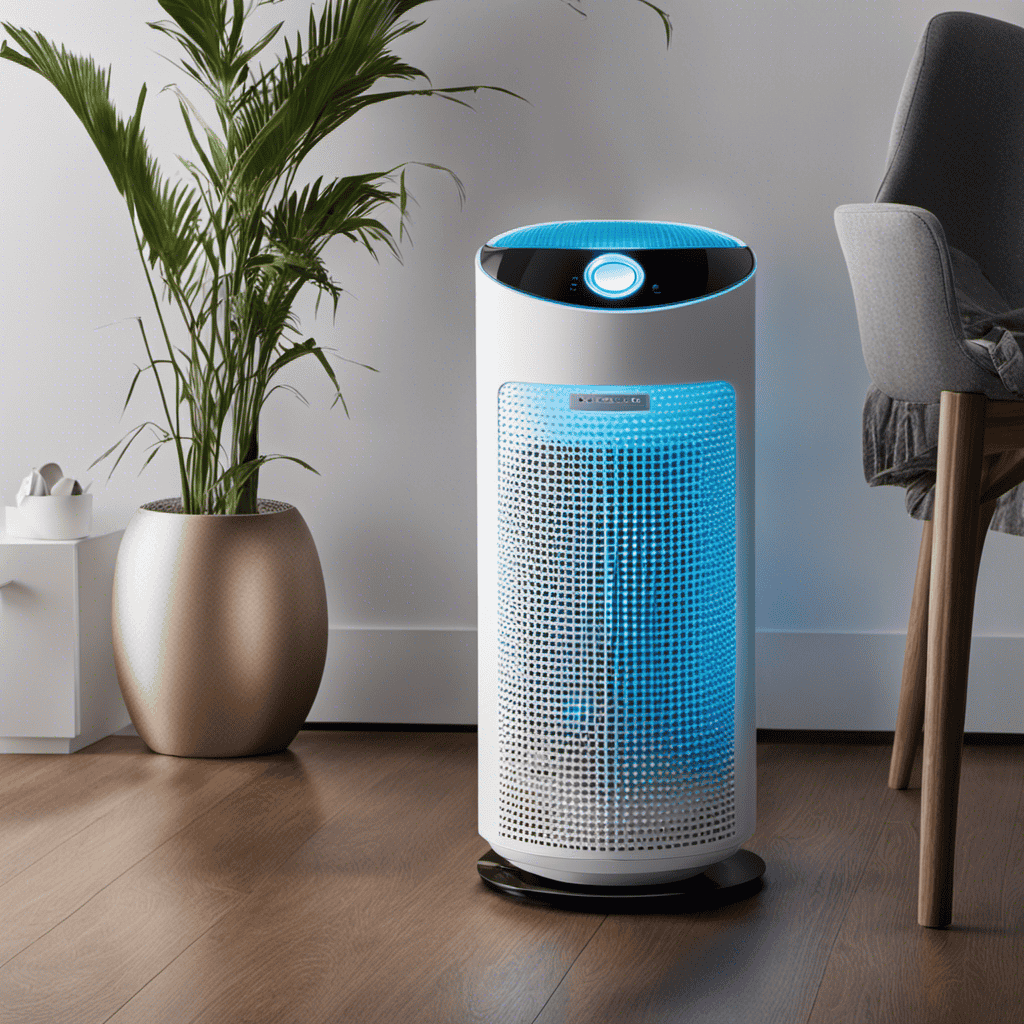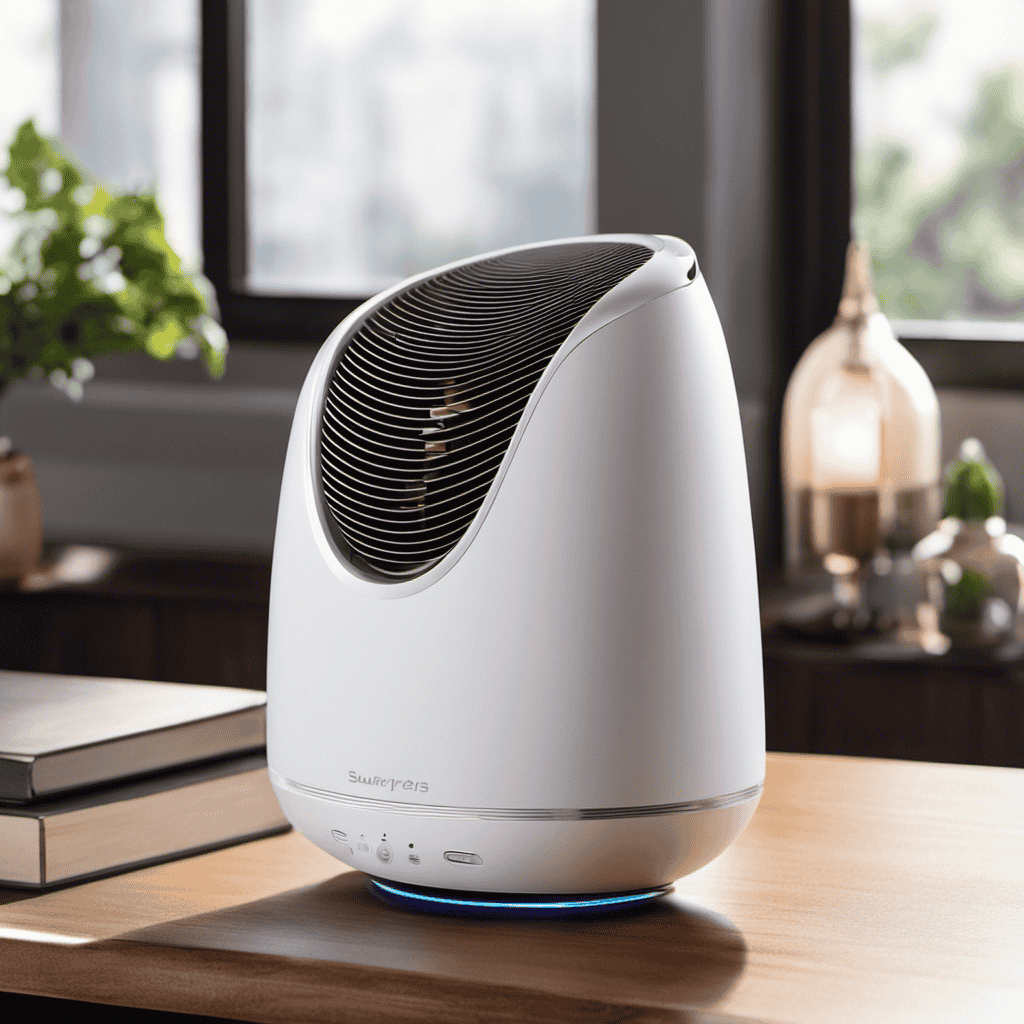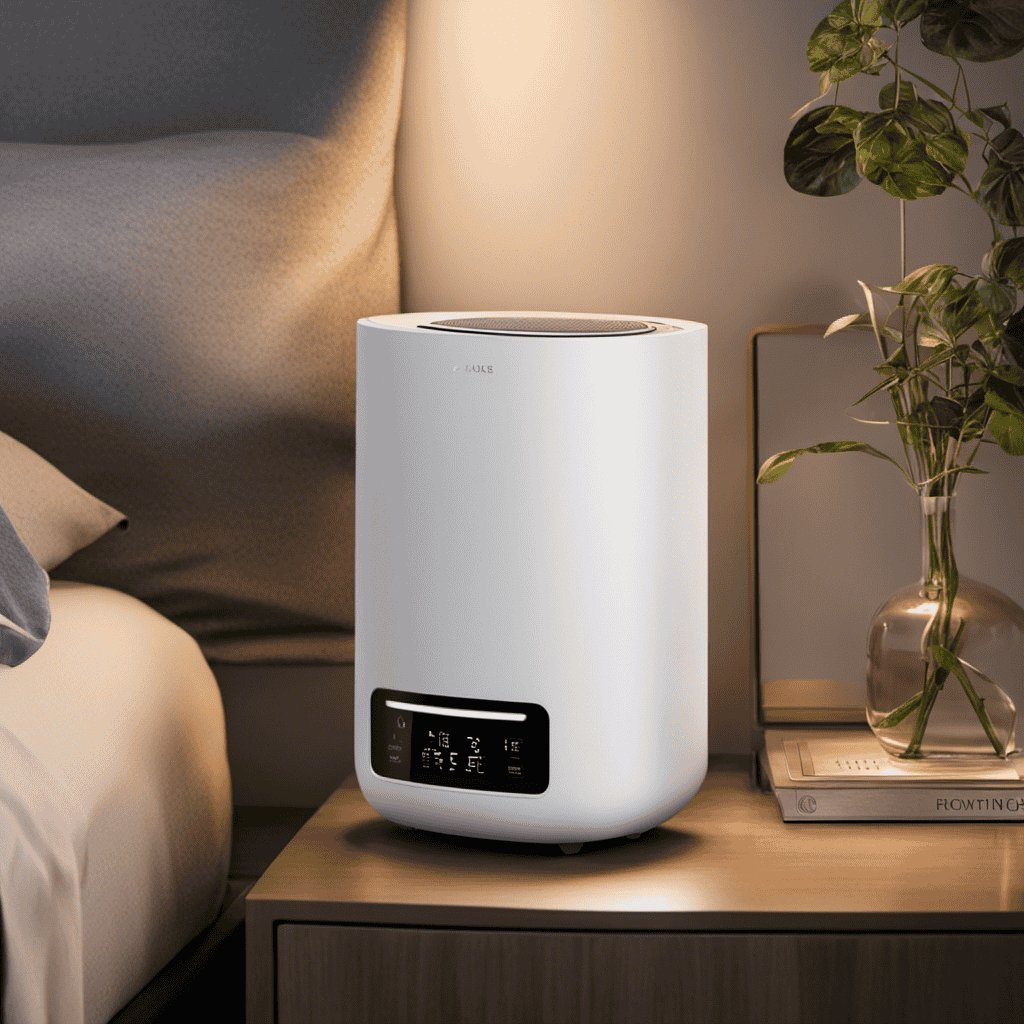When it comes to dealing with allergies, I frequently question whether I should use an air purifier or a humidifier. Both devices promise to relieve allergy symptoms, but which one is more effective?
In this article, we will explore the importance of air quality for allergy relief and delve into the roles that air purifiers and humidifiers play in managing allergies.
By understanding the key differences between these two devices, we can make an informed decision on which one is the best fit for our allergy needs.
Key Takeaways
- Air purifiers remove particles and allergens from the air, while humidifiers add moisture to alleviate dryness and congestion.
- Air purifiers significantly improve allergy symptoms and can be an effective alternative or complement to medication.
- Humidifiers maintain optimal humidity levels, reduce allergens like dust mites and mold, and moisturize dry skin.
- Air purifiers filter out allergens and pollutants, improving indoor air quality, while humidifiers alleviate dryness and discomfort but do not filter out allergens.
The Importance of Air Quality for Allergy Relief
If you suffer from allergies, you need to understand the importance of air quality for finding relief.
Air purifiers and humidifiers are two popular devices that can help improve the air quality in your home, but they work in different ways.
Air purifiers are designed to remove particles and allergens from the air, such as dust, pollen, and pet dander. They use filters to trap these particles, preventing them from circulating in the air and triggering allergy symptoms.
On the other hand, humidifiers add moisture to the air, which can help alleviate symptoms of dryness and congestion.
While both devices have their benefits, it is important to consider your specific needs and consult with a healthcare professional to determine which option will be most effective for your allergies.
Understanding the Role of Air Purifiers in Allergy Management
Understanding the role of air purifiers in managing allergies is crucial. When it comes to allergy relief, many people rely on medication to alleviate their symptoms. However, air purifiers can be an effective alternative or complement to medication.
Research has shown that air purifiers can help reduce allergens in the air, such as pollen, dust mites, pet dander, and mold spores. These devices work by filtering the air and trapping these particles, preventing them from circulating and triggering allergy symptoms.
In fact, a study published in the Journal of Allergy and Clinical Immunology found that using air purifiers in bedrooms significantly reduced airborne allergens and improved symptoms in individuals with allergic rhinitis.
While medication can provide immediate relief, using air purifiers can create a healthier indoor environment and provide long-term relief from allergies.
How Humidifiers Can Help Alleviate Allergy Symptoms
As someone who suffers from allergies, I’ve found that managing humidity levels can greatly alleviate my symptoms.
Research has shown that maintaining optimal humidity levels in the home can reduce the presence of allergens such as dust mites and mold, which are common triggers for allergy sufferers.
One effective way to achieve this is by using a humidifier. It can not only increase humidity levels but also provide additional benefits such as moisturizing dry skin and reducing the likelihood of respiratory infections.
Humidity and Allergy Relief
To relieve allergies, using a humidifier can help by increasing the humidity in your home and reducing symptoms. Maintaining optimal humidity levels is crucial for keeping allergic reactions at bay. Here are three reasons why a humidifier can be beneficial for allergy relief:
-
Moisturizes the air: Dry air can irritate the respiratory system and worsen allergies. By adding moisture to the air, a humidifier soothes irritated nasal passages and reduces the risk of allergic reactions.
-
Reduces airborne allergens: Higher humidity levels make it harder for allergens like dust mites and pollen to float in the air. A humidifier can help minimize their presence, providing relief for allergy sufferers.
-
Relieves dryness and itchiness: Allergies can cause skin irritation and dryness. A humidifier adds moisture to the air, preventing dry skin and alleviating itchiness associated with allergies.
With these benefits, incorporating a humidifier into your allergy management routine can provide much-needed relief from symptoms and improve overall comfort.
Benefits of Humidifiers
Using a humidifier can help relieve dryness and itchiness caused by allergies by adding moisture to the air. The increased humidity can also have additional benefits for sleep quality and preventing dry skin. When the air is too dry, it can lead to dry nasal passages, which can cause snoring and disrupt sleep. By using a humidifier, you can create a more comfortable and conducive environment for sleep. Additionally, dry skin is a common problem during allergy seasons. The added moisture from a humidifier can help prevent dry skin by keeping it hydrated and reducing the risk of irritation and itching. Overall, incorporating a humidifier into your allergy relief routine can have multiple benefits beyond just alleviating allergy symptoms.
| Benefits of Humidifiers | |
|---|---|
| Improved sleep quality | Prevents dry skin |
| Reduces snoring | Alleviates itchiness |
Key Differences Between Air Purifiers and Humidifiers
You’ll want to know the key differences between air purifiers and humidifiers when it comes to dealing with allergies. Here are three important distinctions to consider:
-
Air purifiers filter out allergens and pollutants from the air, while humidifiers add moisture to the air.
-
Air purifiers capture and trap particles such as dust, pollen, pet dander, and mold spores, improving indoor air quality and reducing allergy symptoms.
-
Humidifiers, on the other hand, add moisture to the air, which can alleviate dryness and discomfort caused by allergies, but they do not filter out allergens.
When it comes to allergies, air purifiers are generally more effective at reducing symptoms by removing allergens from the air. However, if dryness is a significant issue, a humidifier can provide relief.
It’s important to assess your specific needs and consult with a healthcare professional to determine which option is best for you.
Choosing the Right Air Purifier for Allergies
When it comes to choosing the right air purifier for allergies, there are a few key points to consider.
First, it’s important to compare different filter types to determine which one is most effective at removing allergens from the air.
Secondly, consider the level of allergy symptom relief that the purifier provides, as some models are designed specifically for allergy sufferers.
Lastly, factor in the cost and maintenance requirements of the air purifier to ensure it aligns with your budget and lifestyle.
Filter Types Comparison
The filters in air purifiers and humidifiers can vary in terms of their effectiveness for allergies. When it comes to choosing the right filter for allergy relief, it’s important to understand the different types available. Here’s a comparison of three commonly used filter types:
-
HEPA filters: Highly effective at capturing allergens like pollen, dust mites, and pet dander. These filters can remove particles as small as 0.3 microns with an efficiency of 99.97%.
-
Activated carbon filters: Great for removing odors and chemicals from the air. They are less effective at capturing allergens but can help with asthma triggers like smoke and volatile organic compounds (VOCs).
-
Electrostatic filters: These filters use an electric charge to attract and trap particles. While they can be effective for larger particles, they may not capture smaller allergens as efficiently as HEPA filters.
When comparing filter types for allergies, HEPA filters are often the most recommended due to their high efficiency in capturing allergens. However, the specific needs and sensitivities of individuals may vary, so it’s important to consider other factors like room size and maintenance requirements when choosing the right filter for your needs.
Allergy Symptom Relief
Using an air purifier or humidifier can provide relief from allergy symptoms. When it comes to managing allergies, many people turn to medication as their first line of defense. However, air purifiers and humidifiers can be effective alternatives that offer natural remedies for allergy relief.
Air purifiers work by removing allergens and pollutants from the air, such as dust mites, pollen, and pet dander. They can help reduce symptoms like sneezing, coughing, and itchy eyes.
On the other hand, humidifiers add moisture to the air, which can soothe dry nasal passages and alleviate congestion. While medication may provide immediate relief, air purifiers and humidifiers offer a long-term solution without the potential side effects of medication.
It’s important to consult with a healthcare professional to determine the best approach for managing your allergies.
Cost and Maintenance
Maintaining an air purifier or humidifier can be costly due to the need for regular filter replacements. However, when it comes to allergies, these devices can provide much-needed relief.
Let’s compare the costs and maintenance requirements of air purifiers and humidifiers.
-
Air Purifiers:
-
Filter replacements: Air purifiers typically require filter replacements every 6 to 12 months, depending on usage. These filters can range in price from $20 to $100, depending on the brand and type of filter.
-
Energy consumption: Air purifiers consume electricity, but the energy usage is generally low, similar to that of a light bulb.
-
Additional costs: Some air purifiers may require additional accessories, such as pre-filters or activated carbon filters, which can increase the overall cost.
-
Humidifiers:
-
Filter replacements: Humidifiers usually have a water tank that needs to be cleaned regularly to prevent bacteria growth. Some humidifiers also require filter replacements, which can cost around $10 to $30.
-
Energy consumption: Humidifiers consume electricity or use water evaporation. The energy usage varies depending on the type and size of the humidifier.
-
Additional costs: Humidifiers may require the use of distilled water to prevent mineral buildup, which can add to the overall cost.
In terms of cost comparison, air purifiers may have a higher upfront cost due to the device itself and the cost of filter replacements. On the other hand, humidifiers have lower upfront costs but may require additional expenses for filter replacements and distilled water. It’s essential to consider these factors when making a decision.
Maintenance tips:
- Follow the manufacturer’s instructions for filter replacements and cleaning.
- Clean the device regularly to prevent mold or bacteria growth.
- Use distilled water or demineralization cartridges to minimize mineral buildup.
Selecting the Best Humidifier for Allergy Relief
When choosing the best humidifier for allergy relief, it’s important to consider the size of the room and the desired humidity level. Evaluating the effectiveness of humidifiers in reducing allergy symptoms is crucial in making the right choice. To help you compare different types of humidifiers for allergy relief, I have created a table below:
| Type of Humidifier | Pros | Cons |
|---|---|---|
| Cool Mist | – Adds moisture to the air | – Requires regular cleaning |
| Warm Mist | – Provides soothing warmth | – Can be a burn hazard |
| Ultrasonic | – Quiet operation | – Requires distilled water |
| Evaporative | – Uses a natural evaporation process | – Filters need to be replaced regularly |
| Whole House | – Covers large areas | – Requires professional installation |
The Benefits of Using an Air Purifier for Allergies
When it comes to reducing allergy symptoms, air purifiers can be highly effective. These devices are designed to improve indoor air quality by removing allergens such as pollen, dust mites, pet dander, and mold spores from the air.
Here are three benefits of using an air purifier for allergies:
-
Reduces allergens: Air purifiers can capture and trap allergens, preventing them from circulating in the air and triggering allergic reactions.
-
Improves respiratory health: By removing airborne pollutants, air purifiers can help alleviate respiratory symptoms such as sneezing, coughing, and wheezing.
-
Creates a healthier environment: Air purifiers contribute to a cleaner and healthier indoor environment, which is especially beneficial for individuals with allergies or asthma.
With the ability to enhance indoor air quality and reduce allergy symptoms, air purifiers are a valuable tool for allergy sufferers. However, it’s important to note that they primarily address airborne allergens, whereas humidifiers can provide relief for respiratory issues caused by dry air.
How Humidifiers Can Soothe Allergy-Related Respiratory Issues
To soothe your allergy-related respiratory issues, consider using a humidifier to add moisture to the air in your home.
Allergy triggers such as pollen, dust mites, and pet dander can cause irritation and inflammation in the respiratory system. Dry air can exacerbate these symptoms, making it harder for you to breathe comfortably.
A humidifier helps by increasing the humidity levels in your home, which can alleviate congestion, coughing, and dryness in the throat and nasal passages. By providing moisture to the air, a humidifier can also help to reduce the spread of airborne allergens.
It is important to note that humidifiers are a natural remedy for allergies, but they should be used in conjunction with other allergy management strategies, such as minimizing exposure to triggers and maintaining a clean home environment.
Combining Air Purifiers and Humidifiers for Maximum Allergy Relief
Combining air purifiers and humidifiers can provide maximum allergy relief. When it comes to combating allergies, it’s important to maximize the effectiveness of our tools. Here are three best practices to consider:
-
Filtering airborne allergens: Air purifiers are designed to remove allergens such as dust, pollen, and pet dander from the air. By using an air purifier in conjunction with a humidifier, you can ensure that the air you breathe is not only clean but also properly humidified.
-
Maintaining optimal humidity levels: Humidifiers add moisture to the air, preventing dryness that can irritate the respiratory system. By combining them with air purifiers, you can maintain an ideal humidity level, reducing the chances of allergy symptoms.
-
Targeting specific allergy triggers: Different allergies require different approaches. By using both air purifiers and humidifiers, you can target specific allergy triggers more effectively. For example, if you have seasonal allergies, an air purifier can filter out pollen, while a humidifier can soothe irritated airways.
Expert Tips for Managing Allergies With Air Purifiers and Humidifiers
Maximize your allergy relief by following these expert tips for managing allergies with air purifiers and humidifiers.
When it comes to managing allergies naturally, both air purifiers and humidifiers play a crucial role. Air purifiers work by filtering out allergens like pollen, dust mites, and pet dander from the air, reducing your exposure to these triggers.
Humidifiers, on the other hand, add moisture to the air, which can help alleviate dryness and irritation in your nasal passages.
Additionally, maintaining a healthy diet can also play a significant role in allergy management. Consuming foods rich in antioxidants, such as fruits, vegetables, and nuts, can help strengthen your immune system and reduce inflammation, thereby minimizing allergy symptoms.
Remember to stay hydrated and avoid foods that may trigger your allergies.
Frequently Asked Questions
Can Air Purifiers Completely Eliminate Allergens From the Air?
Yes, air purifiers can help reduce allergens in the air, but they may not completely eliminate them. Using both an air purifier and a humidifier together can provide better allergy relief than using just one of them.
How Often Should I Clean or Replace the Filters in an Air Purifier?
I clean or replace the filters in my air purifier every 3-6 months to ensure optimal performance. It’s important to choose the right air purifier for allergies and consider the benefits of using a humidifier for allergy relief.
Can a Humidifier Worsen Allergy Symptoms if Not Used Properly?
Using a humidifier can help relieve allergy symptoms by adding moisture to the air. However, if not used properly, it can worsen symptoms by promoting mold growth. It’s important to clean and maintain the humidifier regularly.
Are There Any Specific Types of Air Purifiers or Humidifiers That Are Recommended for People With Allergies?
When it comes to allergies, finding the best air purifiers and most effective types of humidifiers is crucial. As an expert, I can guide you through the options and help you make an informed choice.
Can Using Both an Air Purifier and a Humidifier Together Provide Better Allergy Relief Than Using Just One of Them?
Using both an air purifier and a humidifier together can potentially provide better allergy relief than using just one. Air purifiers help remove allergens from the air, while humidifiers add moisture to relieve symptoms like dryness and congestion.
Conclusion
In conclusion, it is clear that both air purifiers and humidifiers play crucial roles in managing allergies. Air purifiers effectively filter out allergens from the air, while humidifiers help alleviate respiratory issues caused by dry air. By combining the two, maximum allergy relief can be achieved.
It is important to choose the right air purifier for allergies and follow expert tips for managing allergies effectively. With evidence-based knowledge, individuals can make informed decisions to improve their indoor air quality and alleviate allergy symptoms.










